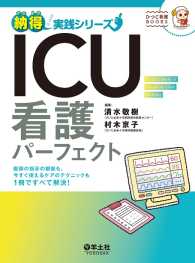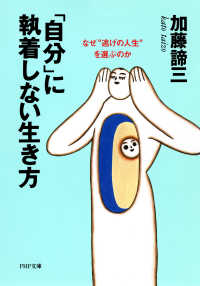- ホーム
- > 洋書
- > 英文書
- > Literary Criticism
Full Description
In this imaginative book, Katie McGettigan argues that Melville's novels and poetry demonstrate a sustained engagement with the physical, social, and economic materiality of industrial and commercial forms of print. Further, she shows that this "aesthetics of the material text," central both to Melville's stylistic signature and to his innovations in form, allows Melville to explore the production of selfhood, test the limits of narrative authenticity, and question the nature of artistic originality. Combining archival research in print and publishing history with close reading, McGettigan situates Melville's works alongside advertising materials, magazine articles, trade manuals, and British and American commentary on the literary industry to demonstrate how Melville's literary practice relies on and aestheticizes the specific conditions of literary production in which he worked. For Melville, the book is a physical object produced by particular technological processes, as well as an entity that manifests social and economic values. His characters carry books, write on them, and even sleep on them; they also imagine, observe, and participate in the buying and selling of books. Melville employs the book's print, paper, and binding-and its market circulations-to construct literary figures, to shape textual form, and to create irony and ambiguity.Exploring the printed book in Melville's writings brings neglected sections of his poetry and prose to the fore and invites new readings of familiar passages and images. These readings encourage a reassessment of Melville's career as shaped by his creative engagements with print, rather than his failures in the literary marketplace. McGettigan demonstrates that a sustained and deliberate imaginative dialogue with the material text is at the core of Melville's expressive practice and that, for Melville, the printed book served as a site for imagining the problems and possibilities of modernity.
Contents
AcknowledgmentsIntroductionImpressions of Authenticity in Typee and OmooBookbindings and Identity in Redburn and White-JacketMetaphors, Markets, and Moby-Dick's "AEsthetics in All Things"Pierre and the Ambiguities of PaperReproducibility, Originality, and Modernity in The Confidence-ManClarel's Poetry and Pilgrimage of PrintConclusionNotesBibliographyIndex
-

- 電子書籍
- ちびまる子ちゃん劇場 不思議・こわい話…
-

- 電子書籍
- ICU看護パーフェクト - 医師の指示…
-

- 電子書籍
- 箱庭テレパシー(1) ポラリスCOMI…
-

- 電子書籍
- 「自分」に執着しない生き方 - なぜ“…




